NVIDIA GeForce GTX 650 Ti Boost Review: Bringing Balance To The Force
by Ryan Smith on March 26, 2013 8:00 AM ESTCompute Performance
As always we'll start with our DirectCompute game example, Civilization V, which uses DirectCompute to decompress textures on the fly. Civ V includes a sub-benchmark that exclusively tests the speed of their texture decompression algorithm by repeatedly decompressing the textures required for one of the game’s leader scenes. While DirectCompute is used in many games, this is one of the only games with a benchmark that can isolate the use of DirectCompute and its resulting performance.
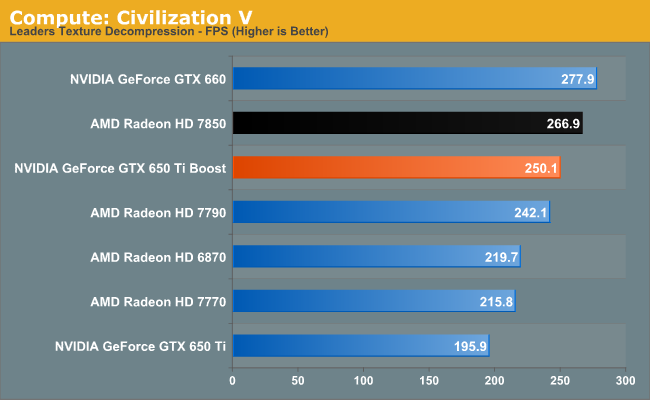
As our Civilization V compute benchmark is just that, a compute benchmark, so our results aren’t too surprising. This is one of the few compute tests NVIDIA does well at, so the GTX 650 Ti Boost is close to both Radeon cards, and not all that far behind the GTX 660 either.
Our next benchmark is LuxMark2.0, the official benchmark of SmallLuxGPU 2.0. SmallLuxGPU is an OpenCL accelerated ray tracer that is part of the larger LuxRender suite. Ray tracing has become a stronghold for GPUs in recent years as ray tracing maps well to GPU pipelines, allowing artists to render scenes much more quickly than with CPUs alone.
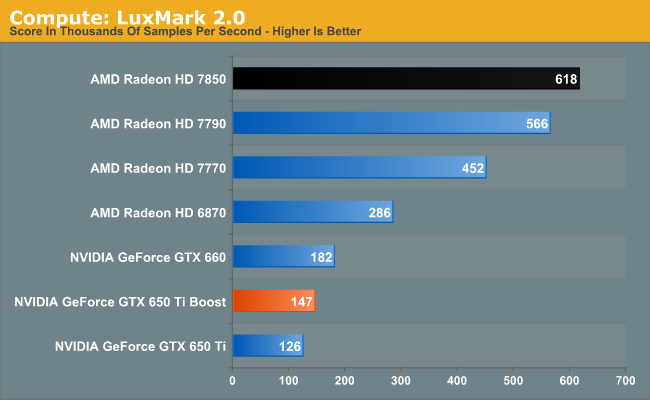
Moving on to LuxMark, we quite frankly transition into a more normal compute benchmark pattern for NVIDIA, which sees Kepler flopping. The GTX 650 Ti Boost can’t get even remotely close to a 7770, let alone the 7850. On the NVIDIA side it doesn’t help that since this is a compute benchmark the GTX 650 Ti Boost gains fairly little over the GTX 650 Ti.
Our 3rd benchmark set comes from CLBenchmark 1.1. CLBenchmark contains a number of subtests; we’re focusing on the most practical of them, the computer vision test and the fluid simulation test. The former being a useful proxy for computer imaging tasks where systems are required to parse images and identify features (e.g. humans), while fluid simulations are common in professional graphics work and games alike.
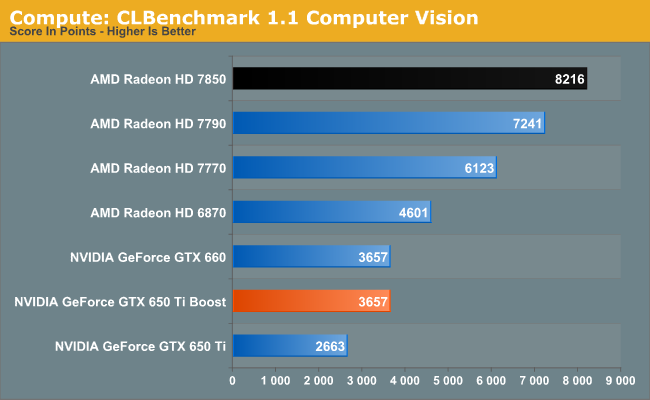
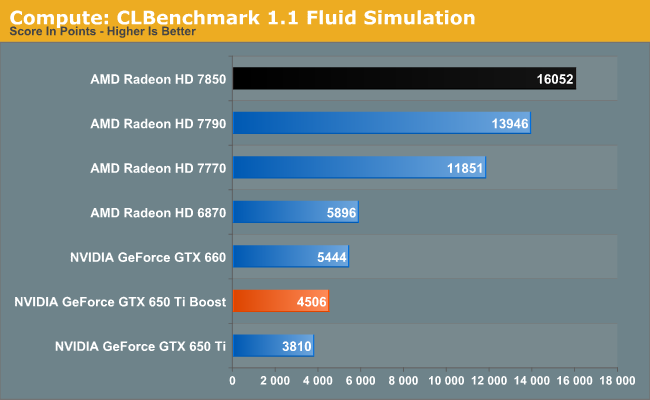
CLBenchmark is much the same as LuxMark, with NVIDIA cards bringing up the rear. The fluid simulation ends up being the more painful of the two benchmarks for the GTX 650 Ti Boost, clocking in at less than 1/3rd the performance of the 7850.
Moving on, our 4th compute benchmark is FAHBench, the official Folding @ Home benchmark. Folding @ Home is the popular Stanford-backed research and distributed computing initiative that has work distributed to millions of volunteer computers over the internet, each of which is responsible for a tiny slice of a protein folding simulation. FAHBench can test both single precision and double precision floating point performance, with single precision being the most useful metric for most consumer cards due to their low double precision performance. Each precision has two modes, explicit and implicit, the difference being whether water atoms are included in the simulation, which adds quite a bit of work and overhead. This is another OpenCL test, as Folding @ Home is moving exclusively OpenCL this year with FAHCore 17.
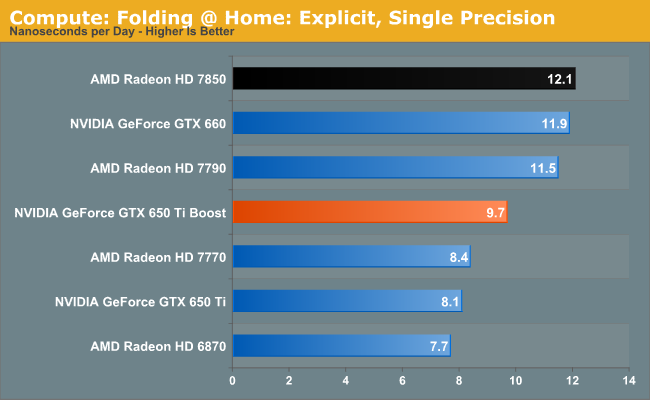
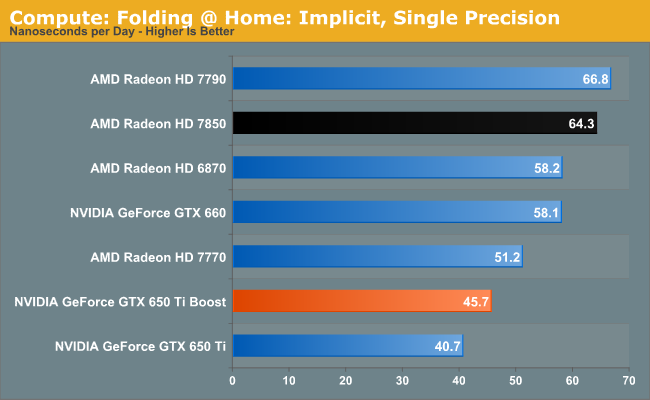
NVIDIA still struggles at compute with FAHBench – the move to OpenCL isn’t doing them any favors – but it’s not the blowout that was our last two benchmarks. Interestingly explicit favors NVIDIA more than implicit, which may mean NVIDIA is handling the overhead better than AMD is. Still, any Folding @ Home users will be far better served by AMD than NVIIDA here.
Our 5th compute benchmark is Sony Vegas Pro 12, an OpenGL and OpenCL video editing and authoring package. Vegas can use GPUs in a few different ways, the primary uses being to accelerate the video effects and compositing process itself, and in the video encoding step. With video encoding being increasingly offloaded to dedicated DSPs these days we’re focusing on the editing and compositing process, rendering to a low CPU overhead format (XDCAM EX). This specific test comes from Sony, and measures how long it takes to render a video.
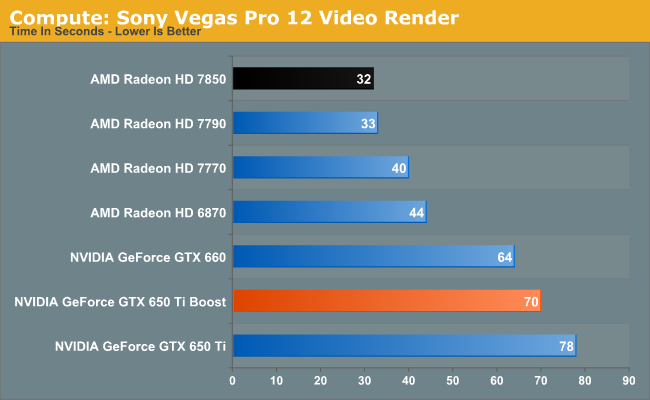
Vegas is another OpenCL benchmark, and another benchmark NVIDIA brings up the rear with. Certainly the additional compute performance of the GTX 650 Ti Boost over the GTX 650 Ti is helping NVIDIA here, but it can’t make up for a gap of over 30 seconds.
Wrapping things up, our final compute benchmark is an in-house project developed by our very own Dr. Ian Cutress. SystemCompute is our first C++ AMP benchmark, utilizing Microsoft’s simple C++ extensions to allow the easy use of GPU computing in C++ programs. SystemCompute in turn is a collection of benchmarks for several different fundamental compute algorithms, as described in this previous article, with the final score represented in points. DirectCompute is the compute backend for C++ AMP on Windows, so this forms our other DirectCompute test.
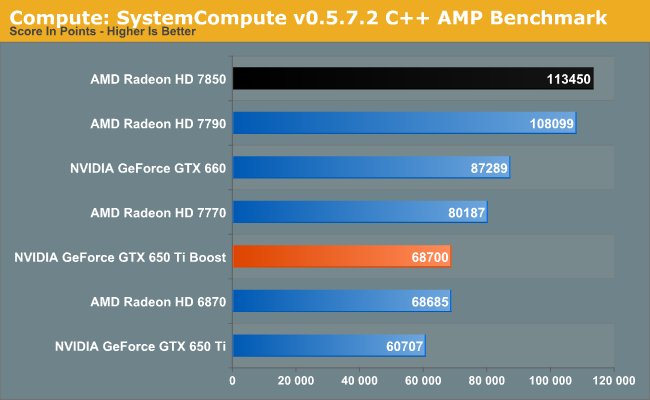
SystemCompute mixes things up a bit with its multiple sub-benchmarks, but it still doesn’t change the fact that Kepler and GTX 650 Ti Boost just don’t do that well in most compute scenarios. 68K points is enough to tie the 6870 of all things, itself not a particular good compute card. Otherwise the bar is set by AMD at over 100K points.










78 Comments
View All Comments
trajan2448 - Wednesday, March 27, 2013 - link
Seems a little disingenuous to avoid comparisons to its direct competitor, the7790, which it handily beats and has better frame delivery times. It wasn't designed to go against the 7850, and you guys know that.FearfulSPARTAN - Wednesday, March 27, 2013 - link
Nvidia seems to thinks so, cant remember the article but Nvidia said the gtx 650 ti boost beat the 7850 in several games, all of them just so happen to be nvidia optimized games though.Ryan Smith - Friday, March 29, 2013 - link
At $169 for the model we reviewed it sure is. It's the $149 1GB card that we need to look at if we want to make meaningful 7790 comparisons.marees - Wednesday, March 27, 2013 - link
"the best card is going to be the card you can afford."The above conclusion should be revised as "the best card is going to be the card+power_supply+cooling_solution you can afford."
I would like a gddr5 card <=$200 which can play latest games at 1080p at the max settings allowed by budget. But I dont want to screw-up my entire pc due to wrong choice of Power Supply or Cooling system/case.
I am sure this has been discussed somewhere before, if not can Anand and his team create a bench / post article to analyse the playable settings of different gddr5 cards along with the additional investment required in terms of case & power supply, esp from a budget gamer point of view - a person for whom it is nice to be able to game, but actually uses the pc mostly for browsing facebook and doing office work.
rbfowler9lfc - Wednesday, March 27, 2013 - link
Why "Ti Boost"? GTX 660, 660Ti, 650, 650Ti and now 650TiB. So many suffixes, that's confusing for the average joe! Why not just plain GTX 655?!?MrSpadge - Tuesday, April 2, 2013 - link
Agreed - this is totally ridiculous!They've already got up to 3 letters for prefixes (but always use the same GTX on any card half-interesting for actual 3D work), 100 different numbers in each generation, now an additional suffix "Ti". Yet that's still not enough, we need another suffix...
Based on performance these should be:
GT640 - GT640
GTX650 - GTX640
GTX650Ti - GTX650
GTX650Ti Boost - GTX655
Darbyothrill - Thursday, March 28, 2013 - link
This may very understandably not be a big consideration for many people, but this card appeals to me a great deal as I am interested in running a Steam Linux Box, and the AMD drivers are currently in an atrocious state for linux. I overall think the AMD cards are more compelling for the price right now, but this is a decently priced nVidia solution.vaibhav81 - Friday, April 12, 2013 - link
guys,I am going to build custom gaming pc. And I Have selected this card for my pc.Can you suggest me other compatible hardware requirement for this,e.g.MotherBoard,PSU,Processor,Case,monitor??lower price will be good.